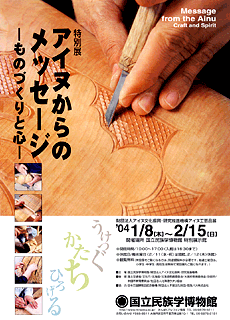Messages from the Ainu: Craft and Spirit
 January 8 (Thu.) - February 15 (Sun.), 2004
January 8 (Thu.) - February 15 (Sun.), 2004
Venue: Special Exhibition Hall, National Museum of Ethnology
Free admission (Admission charge required for visiting the permanent exhibition)
Greetings
We are pleased to announce that we will be holding a craft exhibition entitled “Message from the Ainu: Craft and Spirit.” A long time ago, the Ainu resided mainly in Hokkaido, but also lived in areas ranging from the Tohoku region to southern Sakhalin and the Kuril Islands. The Ainu used their own language, developed oral literature such as Yukar, ceremonies such as “Iomante - the bear spirit-sending ceremony” and had a rich culture, as can be seen in the uniqueness of Ainu patterns. Since the 18th century, the distinctive culture of the Ainu has been attracting many people, and crafts and articles for everyday use created by the Ainu, in particular, have been actively collected by museums and art galleries both in and outside the country in addition to private collectors. Most exhibitions held thus far to introduce Ainu culture have exhibited collections like these, and they were planned and organized by museum curators and researchers with almostno participation by the Ainu themselves. However, ethnographic culture exhibition around the world has recently begun to adopt a new approach in which the ethnic group to be introduced in an exhibition is given the opportunity to decide how their people and culture should be introduced.
We are pleased to announce that we will be holding a craft exhibition entitled “Message from the Ainu: Craft and Spirit.” A long time ago, the Ainu resided mainly in Hokkaido, but also lived in areas ranging from the Tohoku region to southern Sakhalin and the Kuril Islands. The Ainu used their own language, developed oral literature such as Yukar, ceremonies such as “Iomante - the bear spirit-sending ceremony” and had a rich culture, as can be seen in the uniqueness of Ainu patterns. Since the 18th century, the distinctive culture of the Ainu has been attracting many people, and crafts and articles for everyday use created by the Ainu, in particular, have been actively collected by museums and art galleries both in and outside the country in addition to private collectors. Most exhibitions held thus far to introduce Ainu culture have exhibited collections like these, and they were planned and organized by museum curators and researchers with almostno participation by the Ainu themselves. However, ethnographic culture exhibition around the world has recently begun to adopt a new approach in which the ethnic group to be introduced in an exhibition is given the opportunity to decide how their people and culture should be introduced.
Based on these changes, we invited people of Ainu descent to join the planning committee for this exhibition and asked them to take charge of planning and organizing it. This exhibition was therefore created and developed by the Ainu through a process in which they considered, examined and discussed their own culture.
It is our hope that you will be able to understand the message of the Ainu living in the present day through this exhibition.
In closing, I would like to express on behalf of everyone involved our sincere appreciation for the people who loaned us their precious collections, those who made suggestions regarding materials to be exhibited and the countless others who cooperated in the planning of this exhibition.
The Foundation for Research and Promotion of Ainu Culture
Tokushima Prefectural Museum
Tokushima 21st Century Cultural Information Center
Asahikawa City Museum
National Museum of Ethnology
Tokushima Prefectural Museum
Tokushima 21st Century Cultural Information Center
Asahikawa City Museum
National Museum of Ethnology
Organizer:
Foundation for Research and Promotion of Ainu Culture,
National Museum of Ethnology
Foundation for Research and Promotion of Ainu Culture,
National Museum of Ethnology
Support provided by:
Ministry of Land, Infrastructure and Transport,
Agency for Cultural Affairs, Osaka Prefectural Government,
Hokkaido Government,
Hokkaido Board of Education,
Ainu Associaltion of Hokkaido
Ministry of Land, Infrastructure and Transport,
Agency for Cultural Affairs, Osaka Prefectural Government,
Hokkaido Government,
Hokkaido Board of Education,
Ainu Associaltion of Hokkaido






